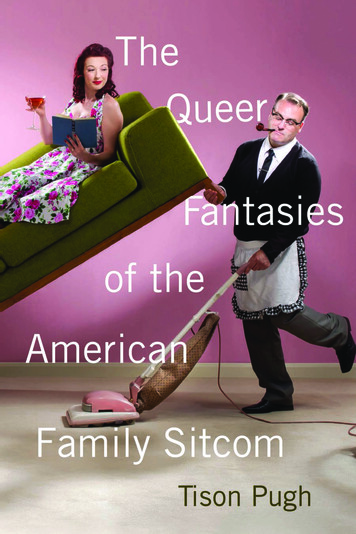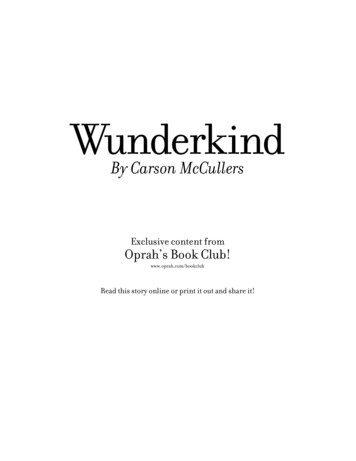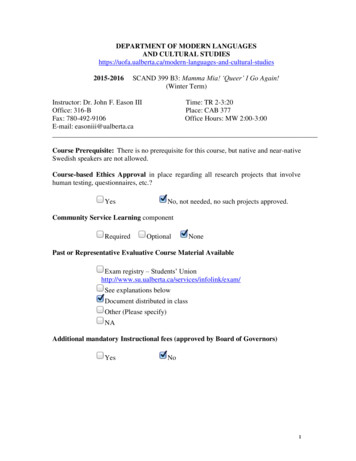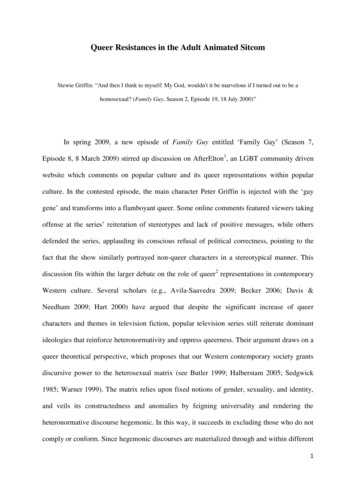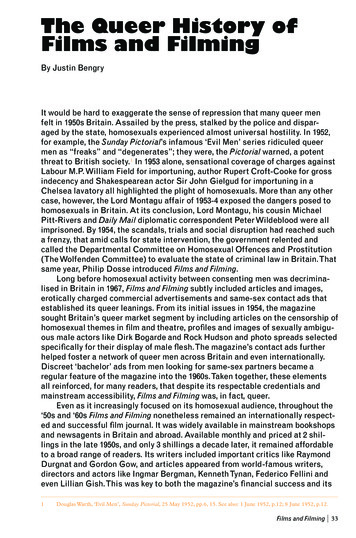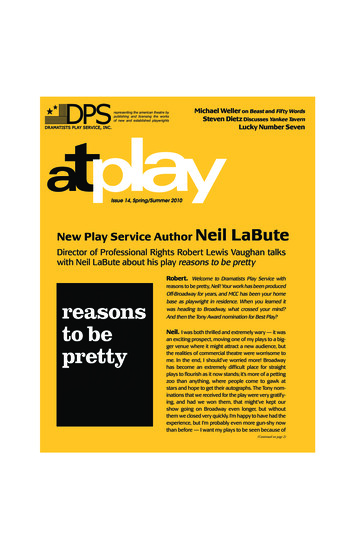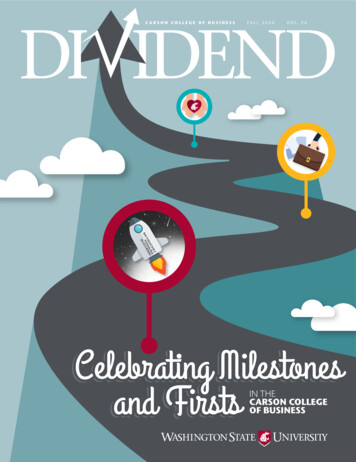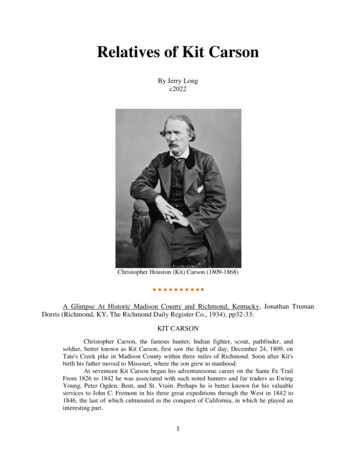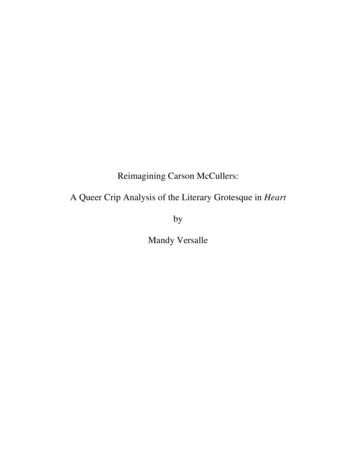
Transcription
Reimagining Carson McCullers:A Queer Crip Analysis of the Literary Grotesque in HeartbyMandy Versalle
Reimagining Carson McCullers:A Queer Crip Analysis of the Literary Grotesque in HeartbyMandy VersalleA thesis presented for the B.A. degreewith Honors inThe Department of EnglishUniversity of MichiganWinter 2018
2018 Mandy Versalle
To freaks everywhere,may our lived experiences always challengethe social construction of “normal.”
AcknowledgmentsThis work would not have been possible without the help of my advisor, MelanieYergeau. Melanie, your patience, understanding, encouragement, and guidance this past yearhave kept me writing through the deepest of writer’s blocks. I cannot say it enough. Thank you,sincerely.I would also like to thank my English and Women’s Studies instructors at the Universityof Michigan, all of whom have helped shaped my writing and thinking into what it is today. Iwould like to call special attention to my 13 instructors at the New England Literature Programwho encouraged me to think outside of the box and who taught me that it’s okay to be a little bitweird; Adela Pinch, upon whose recommendation I first picked up Heart, and Madhumita Lahiri,who has not only willingly read my roughest of drafts but who, by encouraging me to apply forthe Honors Program, has seen me and this project through, from beginning to end.To my friends, who have celebrated and helped me bear all of the ups and downs thathave marked this journey, thank you. Your ceaseless emotional support has kept my head restingfirmly on my shoulders. And finally, to my family, especially my parents, whom I credit with myweirdness, thank you for never clipping my wings.
AbstractCarson McCullers’s 1940 semi-autobiographical novel, The Heart is a Lonely Hunter,has been hailed by critics for its political commentary on mid-twentieth century Southern valuesof personhood. Critics’ analyses of McCullers’s work have historically positioned Heart withinthe context of freakery and the political genre of the literary grotesque. These analyses wereinitially groundbreaking for their time, but more recent works have been unable to move beyondthe unidimensional, gloom and doom approaches that characterized the first analyses of thegrotesque. In this thesis, I will re-examine McCullers’s Heart using Mikhail Bakhtin’s moreproductive understanding of the literary grotesque. Using Bakhtin’s concept of the everunfinished grotesque body allows me to take an intersectional, queer crip approach to identifyingthe ways in which McCullers’s characters both queer and crip the normatively social world aswell as the ways in which they experience the social world through queer crip identities. Throughthis political work, I prove that Heart was written as a form of social protest against the stiflinggender tropes of the Southern Belle and the Gentleman that plagued McCullers’s childhood inmid-twentieth century Southern culture.The introduction of this work positions the reader in the historical context of McCullers’searly life, introducing the Southern values that shaped both her identity and her writing of Heart.I also state my justification for taking on this project, which stems from the failure of othercritics, who have done similar political work with Heart, to recognize McCullers’s characters fortheir intersecting “freak” identities.Chapter one brings in critics such as Bakhtin and Rosemarie Garland-Thomson toestablish a foundation for readers’ understandings of freakish embodiment and the grotesqueperformance, commenting on their roots in 19th century freak show culture as well as mappingtheir expansion into a literary theory, genre, linguistic style, and form of embodiment. I alsoestablish the social positioning of the freak and the political potential of grotesque performances,offering examples from Heart of John Singer’s, Mick Kelly’s, and Biff Brannon’s queer cripexperiences of the social world.Chapter two examines critics’ historically separatist approaches to analyzing McCullers’scharacters as either queer or disabled but then transitions into an argument for more queer cripanalyses of Heart in order to better, and more fully, understand McCullers’s use of the grotesqueas a form of social protest. Borrowing from contemporary queer and disability studies scholars, Itrace the connection between the queer and disabled body, rooting their freakishness incompulsory able-bodiedness and compulsory heterosexuality.The final chapter offers a reimagining of McCullers’s Heart, borrowing from the strictlyqueer or crip analyses of previous Heart critics and inviting readers to reexamine these analysesthrough a queer crip lens. This chapter culminates in a discussion of McCullers’s commitment toexploring controversial topics as a Southern writer in the early to mid-twentieth century, arguingthat the political nature of her fiction is a result of and response to her own experiences growingup as a queer crip writer in a conservative Southern community.Keywords: the literary grotesque, queer crip analysis, Carson McCullers, The Heart is a LonelyHunter, Bakhtin, protest literature
CONTENTSShort Titles . .iIntroduction . .1Chapter 1: The Grotesque . .11Chapter 2: The Queer Crip Identity . 28Chapter 3: Heart Through a Queer Crip Lens . 42Afterword . 58Works Consulted . .60
iShort TitlesBakhtin: Bakhtin, Mikhail. Rabelais And His World. Trans, Hélène Iswolsky. Bloomington:Indiana University Press, 1984.Garland-Thomson: Garland Thomson, Rosemarie. Freakery: Cultural Spectacles of theExtraordinary Body. New York: New York University Press, 1996.Heart: McCullers, Carson. The Heart is a Lonely Hunter. Boston: Mariner Books, 2000.Illumination and Night Glare: McCullers, Carson. Illumintion and Night Glare. Edited byCarlos Dews, The University of Wisconsin Press, 1999.Kafer: Kafer, Alison. Feminist, Queer, Crip. Indiana University Press, 2013.Gleeson-White: Gleeson-White, Sarah. Strange Bodies: Gender and Identity in the Novels ofCarson McCullers. The University of Alabama Press, 2003.McRuer: McRuer, Robert. Crip Theory: Cultural Signs of Queerness and Disability. New York:New York University Press, 2006.Russell: Russell, Emily. ““Marvelous and Very Real”: The Grotesque in The Heart is a LonelyHunter and Wise Blood.” Reading Embodied Citizenship: Disability, Narrative, and theBody Politic. Rutgers University Press, 2011, pp. 59-96.
ii
1IntroductionIt was in a moment of desperation – or rather a moment of illumination, as CarsonMcCullers often referred to her own inspirations for writing (Illumination and Night Glare 32) that I stumbled upon McCullers’s first novel, The Heart is a Lonely Hunter. The final assignmentfor my junior year English seminar was to either craft an essay about one of the dense feministtexts we had read in class that semester - few of which I thoroughly understood - or craft anessay that was relevant to my proposed senior thesis. I was weeks behind on the class readings.Needless to say, I opted for the second prompt.As a Women’s Studies student with a chronic illness, I had done some undergraduateacademic work in the disabled community and was hoping that this work would inform mythesis. However, few, if any, of the countless novels I had read throughout my academic studyexplored the world of disability in the ways that I lived and thought about it. Or, at the very least,my classes had avoided justly discussing the topic when it arose – “Right, right, Mandy, Ali’sparalysis makes him a more sympathetic character” (the response of my high school Englishteacher to the question: How does Ali’s paralysis affect the ways in which he is able to functionas a servant and a father in Khaled Hosseini’s The Kite Runner?). I had no literary foundation orinspiration on which to craft my thesis, so I looked to my professor, Dr. Adela Pinch, forliterature recommendations that were inclusive of characters with disabilities. I was given a brieflist of books to read, with Dr. Pinch’s highest recommendations going to Olive by Dinah Craik.Dr. Pinch is a Victorianist, and as pleasurable as Olive was, I had had my fair share of Victorianthemed undergraduate classes and was quite tired of the era. But the deadline for my final paperwas quickly approaching. In a moment of intense desperation, I gave it the old college try –conducting a Google search for “novels with characters who have disabilities.” I scrolled past the
2Harry Potter series, countless auto-biographies, some John Green novels, and CarsonMcCullers’s Heart.McCullers’s novel had also been on Dr. Pinch’s list, as it was published in 1940 and isnot too far away from the Victorian era. I read a preview of the first few pages on Goodreads.My 10-page proposal was submitted shortly thereafter.In my initial proposal, I looked at the ways in which John Singer, a distant, reserveddeaf 1 individual who communicates via sign language 2; Mick Kelly, a free-spirited tomboy; andBiff Brannon, a quiet, conflicted widower, all move outside the confines of the gender binary inthe novel. In my exploration of queerness, I argued that the characters’ positioning impacts theways in which they are able to experience the social world, with queerness functioning as ameans of “disabling” the characters’ abilities to perform normative social interactions. I exploredthe ways in which their bodies are torn between the physical need to express themselves and theabstract tension of their corporeal relationship to the social world. Naturally, I fell into the pit of1In the Deaf community, there is oftentimes a distinction made between Deaf and deaf, withDeaf representing the cultural identity of deafness and deaf representing the ideologies ofdeafness. John Singer and Spiros Antonapoulos are both Deaf and deaf because they are part of aculture of deafness but they are also ideologically deaf. For this paper, I will refer to thesecharacters as “little d” deaf because this is the term that McCullers uses. Additionally, DeafStudies scholar Brenda Brueggemann challenges the distinction between “Big D” and “little d”deaf, noting how “in the commonplace book of “deafness,” things are not always clearly orsingularly defined, designated, determined as “just” or “pure” or “only” deafness [ ] theselabels – in all cases – are not always accurate, though they may be, as it were, withconsequences” (12).2In Heart, McCullers repeatedly uses the term “deaf-mute” to refer to John Singer and SpirosAntonapoulos, who are both deaf individuals who communicate via sign language. “deaf-mute”was the term of work in the early 1900s, and in order to remain faithful to the ways in whichMcCullers crafted her characters, I will use the term throughout this essay when I am usingMcCullers’s own words to describe her characters. However, the term “deaf-mute” is todayconsidered offensive and inaccurately equates non-speaking with muteness. It is for this reasonthat I will use the descriptor of “deaf individuals who communicate via sign language” to moreaccurately portray and understand John Singer and Spiros Antonapoulos.
3equating queerness with disability and was forced to drastically rethink the ways in whichMcCullers’s queer crip 3 characters function in the novel. I acquired McCullers’s unfinished autobiography, Illumination and Night Glare, with the hope of gaining insight into her writing ofHeart.Illumination and Night Glare, which at the time of its conception, was the working titlefor McCullers’s auto-biography, is a reference to McCullers’s life and writing. Her moments ofintense illumination – rare, fleeting, and unpredictable moments that ignited her imagination andinspired her fits of writing – came “after hours of searching and keeping [her] soul ready”(Illumination and Night Glare 32) to discover the truths of the stories that she wanted to tell.McCullers referred to these illuminations as flashes and as religious phenomena that helped herescape from the darker, more frequent night glares that often left her in a senseless trance andunable to write (Illumination and Night Glare 31). These night glares followed the traumaticevents of McCullers’s life – a life consumed by injustice, sickness, and death.McCullers was raised in a small town in Georgia, where she notes that she inhabited a“backward Southern community” (Illumination and Night Glare 16) with certain hideousaspects, such as blatant racism, that she would later spend two years contemplating beforewriting Heart (Illumination and Night Glare 62). There is one particularly racist incident thatoccurred during the Depression-era of McCullers’s childhood that had a lasting effect on her, andits impact can be felt in the way that she writes of Dr. Copeland and race relations in Heart. Atthe time, McCullers’s 14-year-old African American nurse and cook, Lucille, was denied a ride3I borrow this term from Alison Kafer’s Feminist, Queer, Crip, where she uses “queer crip” todescribe individuals who are both genderqueer and disabled. The use of the identifier “crip” is anintentional act of reclamation, chosen for its shock factor and consequent ability to startimportant political conversations.
4in a public taxi late one night after work and was consequently forced to walk many miles homein the dark (Illumination and Night Glare 54).This is not the only event of McCullers’s life that shaped her fiction, however.McCullers, herself, has admitted, “Everything that happens in my fiction has happened to me, orit will happen eventually” (Carr 105).Echoes of McCullers’s experiences of the social world and non-normative socialperformances can be seen in her portrayal of Mick as a socially awkward teenage girl in Heart.McCullers self-identified as a socially awkward child who cared much more for her piano musicthan for the musings of other children (Illumination and Night Glare 13). McCullers is quoted:“I’m sure I missed certain social advantages by being such a loner, but it never bothered me”(Illumination and Night Glare 12). This preference for loneliness followed McCullers intoadulthood and was often the prerequisite for her moments of illumination. She required absolutesolitude to write, and, even throughout adulthood, she often abandoned her husband and herlavish life of fame in New York to return home to her parents’ house in Georgia. She would latercite her reasons as overstimulation caused by chaotic city life and severe bouts of homesicknesscoupled with an intense longing for solitude (Illumination and Night Glare 30).Also like Mick, McCullers was unable to escape all of the normative socialization thataccompanies one’s coming-of-age. She recalls that, despite her lack of beauty, her mother didher damndest to fuss over McCullers, keeping her as dainty and beautiful as was possible(Illumination and Night Glare 58). Despite these attempts, however, McCullers, like Mick,actively defied the normative performance of womanhood and instead appeared androgynous formost of her life. She kept her hair short and often un-styled, and she was frequently
5photographed in trousers rather than a skirt, especially in the presence of her male-dominatedsocial and professional circles (Illumination and Night Glare 29).But where McCullers’s life appears most prominently in her fiction is in the momentsshaped by her own periods of night glare. The ever-present undertone of illness and impairmentthat functions as the backbone of Heart is a somewhat tamed version of McCullers’s reality. Anundiagnosed and later mistreated case of rheumatic fever in McCullers’s early childhood resultedin a life of debilitating strokes and convulsions, numerous infections, partial paralysis, impairedvision, depression, anxiety, a miscarriage, chronic fatigue, the need to amputate a limb, aninability to walk, a 47-day period of comatosis, and her eventual death. These illnesses andimpairments were infrequent in McCullers’s early life and caused only brief moments of nightglare that temporarily numbed her artistic creativity. However, McCullers’s final years were oneunending night glare, as severely debilitating strokes resulted in the loss of her ability to write,and the tragedies of her social life – the suicides of Reeves (husband), Annemarie ClaracSchwarzenback (close friend), and her long-time psychiatrist along with the early andunexpected deaths of her mother and her close friends Richard Wright and John La Touche –became too much for her to bear (Illumination and Night Glare).Her characters’ ongoing battles with mental illnesses were also reflections of McCullers’spersonal life. Not only was McCullers, herself, depressed, but her husband, Reeves McCullers,was a depressed alcoholic with PTSD from World War II, and he eventually took his own life.Before his death, however, Reeves attempted suicide multiple times and even encouraged hiswife to commit suicide alongside him. The couple’s relationship had always been turbulent.Their marriage failed twice, and in her autobiography, McCullers noted that she wished she and
6Reeves had just remained friends, as her abusive relationship with him left her in a constant stateof depression (Illumination and Night Glare 39).Carlos Dews, the editor of McCullers’s autobiography, notes that, like their marriage – orperhaps because of their marriage – McCullers and Reeves’s sex life was also a failure, andMcCullers was admittedly “disappoint[ed] in the sexual dimension of her relationship withReeves,” (xxi). “The sexual experience was not like D. H. Lawrence 4” (Illumination and NightGlare 6), McCullers noted in response to her dissatisfactory sex life with Reeves. The reasonwhy the couple’s sex life and marriage repeatedly failed, however, is highly contested. Oneargument is that the pair’s personal illnesses caused great strain on their relationship, andMcCullers’s literary success only intensified this strain as it was a source of jealousy for Reeves(Illumination and Night Glare 39). Others argue, however, that McCullers, owing to the“backward Southern community” (Illumination and Night Glare 16) in which she lived, spenther life suppressing her bisexuality or lesbianism and was therefore uninterested in a romanticrelationship with Reeves. The evidence throughout Illumination and Night Glare as well asMcCullers’s fiction strongly supports the latter argument.Inspired by Isadora Duncan’s My Life, McCullers recalled in her autobiography spendingmuch of her childhood preaching “free love” (Illumination and Night Glare 54). While writingIllumination and Night Glare, she often reflected on the beauty of her female doctors(Illumination and Night Glare 74) and recalled fondly the first and last times she kissed herfemale friends – most notably Annemarie Clarac-Schwarzenback (Illumination and Night Glare35). Dews, the editor of Illumination and Night Glare, notes that McCullers’s relationships with4This is a reference to the sexually explicit nature of D. H. Lawrence’s formerly controversialnovel, Lady Chatterley’s Lover, which was banned for being too pornographic and obscene forits time.
7her female friends often appeared more intimate than her relationship with Reeves, and whenconfronted by Reeves at a low point in their marriage, McCullers noted feeling confused aboutwhether she was in love with her friend Annemarie Clarac-Schwarzenback (Illumination andNight Glare 22). Much like her characters Singer and Biff, McCullers was forced to performnormative sexuality in a world that demonized her queerness.But this recounting of McCullers’s androgyny, disability, and queerness is not hercomplete life story. There is a consensus among scholars of McCullers’s work 5 that her true andcomplete autobiography is “submerged below the surface of her fiction” (Dews xiv). Whatreaders are left with, then, is an interesting social experiment in which McCullers used her lifeexperiences to shape the lives of her characters. The consequences for her characters areultimately comparable to the consequences that she faced, but the lasting social impact ofMcCullers’s life is hardly comparable to that of Heart.Although McCullers mirrored her childhood hometown when recreating the smallGeorgia mill town of Heart, and her queer crip characters embody many of McCullers’s ownqualities, the impact of her characters’ existence is different. McCullers was a real personconfined by the sociopolitical and geographic limitations placed on bodies in the material world.McCullers’s characters, albeit informed by the social laws that bound McCullers in the materialworld, exist in the world of literature, and their limitations when performing non-normative5In addition to Dews, Virginia Carr and Nancy B. Rich comment on the duplicity betweenMcCullers’s novels and her personal life in their respective works, The Lonely Hunter: ABiography of Carson McCullers and The Flowering Dream: The Historical Saga of CarsonMcCullers. Carr quotes McCullers: “Everything that happens in my fiction has happened to me,or it will happen eventually” (105). Rich comments that McCullers’s novels “were a statementon the motives, emotions, and actions found in the daily lives of regular people” in McCullers’sSouthern community (7).
8social scripts were, and continue to be, not as consequential as McCullers’s were. In the literaryworld, McCullers controlled her characters’ outcomes. They could perform non-normative socialscripts on paper in ways that McCullers would never be able to perform in the material world.Her writing was therefore a means of living her life the way that she wanted and needed to butnever could. She had more freedom to experiment with her fiction than she had with herself, andher experimental fiction was able to reach a larger audience. Heart had a life of its own – thatwas a close mirroring of McCullers’s life but notably different – and that life had a lasting andglobal social impact. It is for this reason that many scholars would agree 6 that McCullers’scommitment to exploring and experimenting with controversial and taboo topics as a Southernwriter in the early to mid-twentieth century – the injustice of racism and poverty, as well as thefluidity of sexuality, gender expression, and disability, to name a few - was a result of andresponse to her own experiences growing up in a conservative Southern community. Her writingof Heart was a means of protesting her corporeal restrictions in the material world, whereMcCullers’s own social performances were limited by her Southern community’s view of nonnormativity as freakish and grotesque.But McCullers capitalized on the social interpretation of non-normative performance –queerness, gender fluidity, and disability – as grotesque and freakish. In fact, following theheight of freak shows in 19th century England and the United States, the literary grotesquebecame a popular genre of writing and lens of academic analysis. Characterized by those whohave been culturally deemed “anomalous beings” – which would have included McCullers andher non-normative characters – the literary grotesque has been an avenue through which literary6From The Flowering Dream: The Historical Saga of Carson McCullers, “It’s exploration of theproblems of racism, poverty, and labor suggest that it is a social protest novel” (Rich 10).
9critics analyze the functionality of “social bod[ies] gone awry” (Russell 60). The literarygrotesque, however, has also been a limited means through which critics analyze Heart. The lenshas historically resulted in negative, unidimensional approaches to analyzing characters whoseidentities are far more complex than what they are perceived to be.Analyses of McCullers’s characters, under the lens of the literary grotesque, were initiallygroundbreaking for the mid-twentieth century, but modern critics of McCullers, such as EmilyRussell, Nancy B. Rich, and Sarah Gleeson-White, with whom I will be conversing in this thesis,have been unable to move beyond the gloom and doom that frequently categorizes the literarygrotesque. The gloom and doom approach often taken to analyze Heart echoes Aristotle’s ageold view of women: female characters are grotesque because they are viewed as lesser men,disabled bodies as incomplete bodies, and so on, comparing each “anomalous” being to itssocially accepted counterpart. This negative approach leads to obvious conclusions: John Singeris grotesque because he is deaf, and Mick Kelly is grotesque because she is a tomboy, and so on.The second pitfall of these critics’ analyses of Heart is that, even those who move beyondthe gloom and doom approach often do McCullers’s characters an injustice by taking aunidimensional approach to the consideration of the characters’ identities. Like McCullersherself, McCullers’s characters are queer, crip, gender fluid beings, but they have been rarely, ifever, analyzed in the context of holding these multiple intersecting identities. Rather, critics haveinterpreted these characters as grotesque through either a queer studies lens – usingpsychoanalytic theory to assess their gender fluidity or queer love – or through a disabilitystudies lens to assess their impairments. Rather than taking a productive, intersectional approachto analyzing how McCullers’s characters embody the literary grotesque, critics often overlookMcCullers’s central focus in creating radical, complex characters that defy social norms. Readers
10are then left with flat, simplistic conclusions to what should be complex characters that reflectMcCullers’s profound experience of and resistance to her own strict social world.Critics’ strictly queer analyses or strictly crip analyses of the literary grotesque in Heartare incredibly limiting. When critics take such a limited critical approach to analyzingMcCullers’s work, they deny readers the opportunity to understand McCullers’s indispensablemid-twentieth century insight into what it means to queer and crip the social as well as howcharacters experience the social world through queerness and disability. In other words, whenreaders understand Heart through this limited lens, they don’t fully understand what it means tobe freakish, and they can’t fully comprehend McCullers’s use of the grotesque as a form ofsocial protest. Regardless of how scholars have interpreted McCullers’s work, however, there isvalue in seeing and recognizing both the queerness and disability of McCullers’s charactersunder the scope of the literary grotesque. To do so allows us to also see and understandMcCullers’s intersecting social positionings and the ways in which she crafted Heart as apolitical response to her own experiences growing up in a conservative Southern community.To name only one – queerness or disability – is to deny the presence and importance ofthe other. McCullers and her characters’ freakish existence and grotesque performances, whenviewed through the combined lenses of queer and disability studies, challenge the hegemonicview of the relationship between one’s body, one’s self, and one’s social environment as beinginherently congruent (my body performs what myself and society want it to perform). In onlyacknowledging the queerness of the characters or the cripness of the characters as that whichmakes them freakish, critics cannot fully understand the ways in which McCullers craftedsocially defiant, radical, and complex crip queer characters. At the completion of this work,throughout which I will take a multidimensional approach to analyzing the grotesque nature of
11McCullers’s characters, readers will have a broader, more productive lens through which tounderstand McCullers’s use of the grotesque as a mechanism for bringing about social change.Chapter 1: The GrotesqueMikhail Bakhtin, whose productive work on grotesque realism counters the all-toocommon gloom and doom narrative of McCullers’s critics, credits German writer HeinrichSchneegans with documenting the history of the grotesque and crafting the first literary theory ofthe grotesque, after which our modern understanding is modelled (304).Since Schneegans’ work in 1894, authors’ and critics’ use and understanding of thegrotesque has expanded from its original designation as a literary theory to a more modernumbrella term that encompasses the grotesque as a literary genre, linguistic style, theory, andform of embodiment. Its expansion, and oftentimes consequent obscurity, is due, in part, to theconstant conflagration of freakishness with the grotesque.In literary analysis, the freak exists in close relation to the grotesque, as one must first bea freak in order to be grotesque, and in the presence of freakishness, there is always the potentialfor a performance of the grotesque. But unlike the grotesque, freakishness is merely visualdifference (Garland Thomson Freakery 1) - a corporeal performance of the seemingly abnormal.Freaks, or rather, marvelous and deviant corporeal curiosities, as Rosemarie Garland Thomsondeems them, possess an excess or a lack that threatens the organizational principles ofpersonhood (5). This imagined excess or lack is bodily, and is often used to mark non-normativebodies as freakish for being too abnormal (excess) and not human enough (lack). Therefore,freakishness is a broad category, with freaks ranging from “fat ladies, albinos, bearded women,Siamese twins, and armless and legless wonders” to “giants, cannibals, midgets, hermaphrodites”(5), and in Heart, specifically, queer and disabled bodies. What makes these bodies freakish is
12that their existence “gesture[s] toward other modes of being [by] confusing comfortingdistinctions between what is human and what is not” (Garland Thomson Freakery 1). Theseseemingly monstrous and deviant bodies “violate culture bound expectations” (3), chall
as a servant and a father in Khaled Hosseini's The Kite Runner?). I had no literary foundation or inspiration on which to craft my thesis, so I looked to my professor, Dr. Adela Pinch, for literature recommendations that were inclusive of characters with disabilities. I was given a brief list of books to read, with Dr. Pinch's highest recommendations going to Olive by Dinah Craik. Dr .
